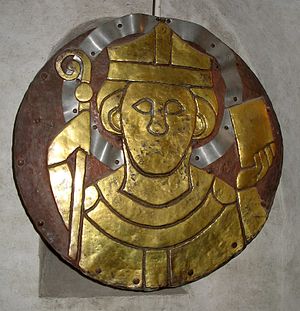Conrad of Constance
Saint Conrad of Constance | |
|---|---|
 Copper plate showing Saint Conrad. From the crypt of Cathedral of Konstanz. | |
| Born | c. 900 |
| Died | 26 November 975 |
| Venerated in | Eastern Orthodox Church Roman Catholic Church |
| Canonized | 1123, First Lateran Council by Pope Callixtus II |
| Feast | 26 November |
| Attributes | represented as a bishop holding a chalice with a spider in it or over it. |
Conrad of Constance (‹See Tfd›German: Konrad von Konstanz; Latin: Conradus, Curtius; c. 900 – 26 November 975) was a German bishop and saint.
Life
Conrad was a member of the powerful Welf family, son of Count Heinrich of Altdorf. After an education at the cathedral school in Constance, he became provost of Constance Cathedral and in 934 was made Bishop of Constance.
It is counted as one of his achievements that he avoided becoming enmeshed in the politics of the day and reserved his energies for his episcopal duties. He was nevertheless close to Emperor Otto I, whom he accompanied to Italy in 962. Conrad made three pilgrimages to Jerusalemas well as a number to Rome. He founded a number of churches on the episcopal estates and the hospital at Kreuzlingen, named after a portion of the True Cross which Conrad brought back from Jerusalem and presented to it.
Veneration
His remembrance as a role model for courage was entirely due to the efforts of Bishop Ulrich I of Dillingen, Bishop of Constance (1111–1127). The Vita of Conrad was written in about 1120 by Udalschalk, a monk of St. Ulrich's and St. Afra's Abbey, Augsburg, of which he later became abbot (1124 or 1127 to c. 1150 or 1151). Its late date doubtless accounts for its lack of content, notwithstanding which, Conrad was canonised at the First Lateran Council in 1123.
Iconography
Saint Conrad is sometimes represented as a bishop holding a chalice with a spider in it or over it. This refers to a story that once when he was celebrating mass a spider fell into the chalice. Spiders were believed at that time to be deadly poisonous, but Conrad nevertheless drank the Blood of Christ, which had been transubstantiated from wine, with the spider in it, as a token of faith.
See Also
Lua error in mw.title.lua at line 346: bad argument #2 to 'title.new' (unrecognized namespace name 'Portal').
Sources
- Adriaan Breukelaar (1992). "Konrad von Konstanz". In Bautz, Traugott (ed.). Biographisch-Bibliographisches Kirchenlexikon (BBKL) (in Deutsch). Vol. 4. Herzberg: Bautz. cols. 416–417. ISBN 3-88309-038-7.
- St. Patrick's Church: Conrad of Constance Archived 2019-12-29 at the Wayback Machine
External links
- "San Corrado di Costanza". Santiebeati.it (in italiano).
- "Saint Conrad of Constance". CatholicSaints.Info.
- Pages with script errors
- Short description with empty Wikidata description
- Articles without Wikidata item
- Articles containing German-language text
- Pages using Lang-xx templates
- Articles containing Latin-language text
- CS1 Deutsch-language sources (de)
- Webarchive template wayback links
- CS1 italiano-language sources (it)
- German Roman Catholic saints
- Roman Catholic bishops of Constance
- 10th-century German bishops
- 900s births
- 975 deaths
- 10th-century Christian saints
- Elder House of Welf